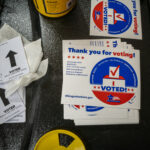When the Center for Community News based at the University of Vermont launched its Elections & Democracy Reporting Initiative in August, its goal was to give student reporters the space and resources to fill the gaps in local election reporting. By mid-October, 125 colleges across 46 states had expressed interest in being a part of the project.
Since the initiative began in August, it has been a race to November, said Sarah Gamard, program manager for the CCN overseeing the project.
Because most local media outlets don’t have the staff or resources to cover every race in their community, the students are filling the gaps.
“Local politics matters, local elections matter, and, in some cases, affect readership more than the presidential election,” Gamard said.

Institutions that are part of the initiative’s cohort send their election stories to CCN after being published on their own platforms, ranging from campus newspapers to university-related nonprofit outlets to news services. Upon receiving the stories, CCN publishes them on the National Community News Wire’s Election Hub. Though it’s not an exhaustive list, it serves as an aggregation of work students are doing across the nation this election season, Gamard said.
Across 10 of the 12 Midwestern states, 23 institutions have joined the Elections & Democracy Reporting Initiative, Gamard said. One is Denison University. The Reporting Project, from Denison University’s journalism program, is a nonprofit news organization born in 2020 that covers Licking County, Ohio, and its surrounding regions. With the goal of being the local news source for the Licking County community, Julia Lerner, managing editor of The Reporting Project who advises the students, said the initiative has increased its election coverage.
Denison’s location in Central Ohio, not far from Springfield, Ohio, where big-ticket issues like immigration are at play, lends itself to a “great experience for our students who are learning how to do this in a place where elections are pretty contentious and will mean something,” Lerner said.
“Giving our students the opportunity to actually cover these major issues in a way that is supportive of our community is a game changer,” Lerner said.
Corey Ohlenkamp, director of Unified Media at Ball State University in Muncie, Indiana, who oversees four student publications at Ball State, said the resources provided through the initiative — including tip sheets on election coverage and a community of people all working toward the same goal — provide a huge confidence boost to student journalists.
“It’s vital,” Ohlenkamp said. “It’s a chance to lean in and say, ‘How are other people approaching this?’”
Races like county coroner and auditor are ones students might not know a lot about, Ohlenkamp said, but the initiative gives students the ability to look at others’ coverage in different areas to understand reporting options. Seth Richardson, lecturer of journalism at the University of Minnesota, said there is generally a lot less coverage for local elections, which can be the ones that prepare people to be civically engaged through their lives.
“Expanding both the number of angles that we can explore, as well as the types of people who are exploring those angles can give us a more well-rounded understanding of this election,” said Richardson, who added that he sees political coverage as the foundation of newsroom coverage.
Part of the importance of this initiative is connected to the fact that many colleges and universities — especially ones in rural counties — are located in news deserts, Gamard said.
“It’s not ideal that we exist with news deserts. It’s not good for any communities,” Gamard said.
“So a solution right now is to have student reporters learn the ropes by just helping professionals in ways that they can.”
In 2023, the Northwestern Medill Local News Initiative labeled 1,766 counties in the U.S. as news deserts, defined by each county having one or zero local newspapers. Only the south has fewer media outlets than the Midwest. Of the Midwest’s rural college campuses, 206 are located in or adjacent to counties with one or zero local news outlets.
Franklin College in Franklin, Indiana, also participates in the initiative. Located about 25 miles south of the state’s capital of Indianapolis, Colleen Steffen, executive editor of
TheStatehouseFile.com at Franklin College, said they’re in a “weird news ecosystem,” especially since Indiana has the second lowest voter turnout in the nation after West Virginia.
“We’re really saturated for political news in Indianapolis, which is kind of a weird situation to be in,” explained Steffen, who is also a lecturer of journalism. “So the students and I really have to look for holes in the coverage and little places that we can contribute and not repeat.”
Faculty at higher education institutions who encourage and guide student reporters through the learning process — from writing candidate profiles, to sifting through court records, to finding out if candidates are really who they say they are — give Gamard hope.
“It’s incredibly important for the students to learn this stuff,” Gamard said. “Of course, not all of these students are going to become reporters, but they are going to become more engaged citizens, and hopefully that will create a ripple effect.”
Allie Miller is a Pittsburgh-based freelance journalist.
- Institutions of journalism accountability disappear
- Episode 2: When a university tries to stop the press
- When Teen Vogue’s newsroom went silent, so did a generation’s voice.
- Pulitzer value of independence infuses 50 year journey from rookie reporter, to globe-trotting correspondent to founder of nation’s leading news nonprofit
- As AI in journalism takes root, safeguards and training are needed. Treat AI like an enthusiastic intern who has to be checked

